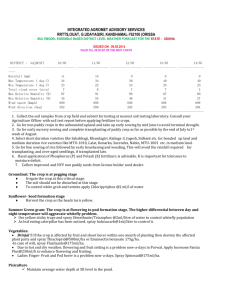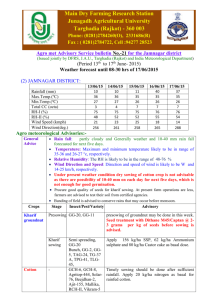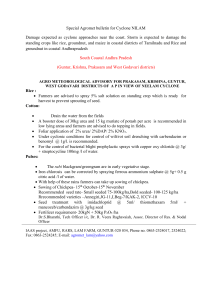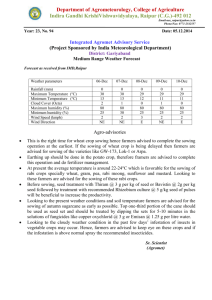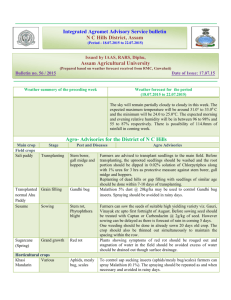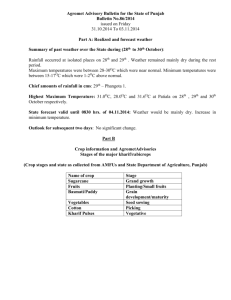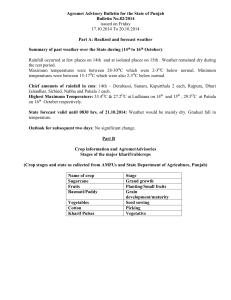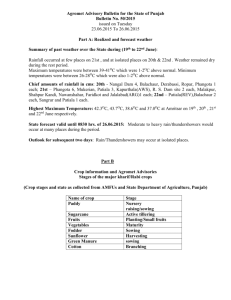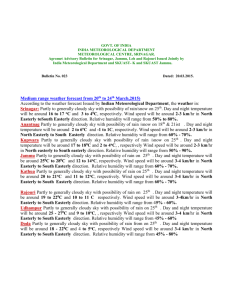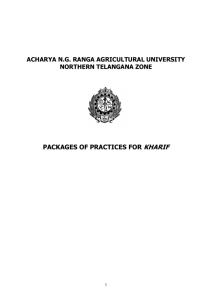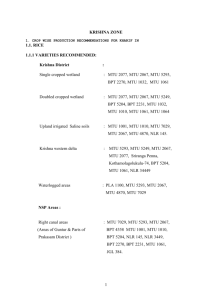Make the autumn sowing count - Dairy Fertility Investigator
advertisement
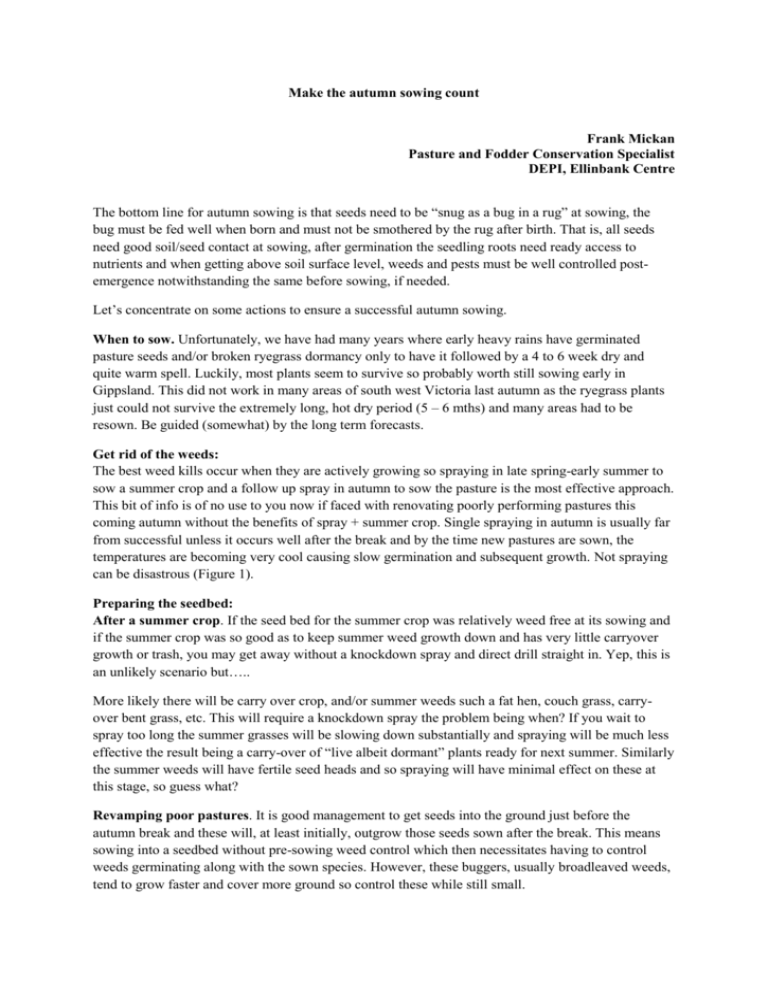
Make the autumn sowing count Frank Mickan Pasture and Fodder Conservation Specialist DEPI, Ellinbank Centre The bottom line for autumn sowing is that seeds need to be “snug as a bug in a rug” at sowing, the bug must be fed well when born and must not be smothered by the rug after birth. That is, all seeds need good soil/seed contact at sowing, after germination the seedling roots need ready access to nutrients and when getting above soil surface level, weeds and pests must be well controlled postemergence notwithstanding the same before sowing, if needed. Let’s concentrate on some actions to ensure a successful autumn sowing. When to sow. Unfortunately, we have had many years where early heavy rains have germinated pasture seeds and/or broken ryegrass dormancy only to have it followed by a 4 to 6 week dry and quite warm spell. Luckily, most plants seem to survive so probably worth still sowing early in Gippsland. This did not work in many areas of south west Victoria last autumn as the ryegrass plants just could not survive the extremely long, hot dry period (5 – 6 mths) and many areas had to be resown. Be guided (somewhat) by the long term forecasts. Get rid of the weeds: The best weed kills occur when they are actively growing so spraying in late spring-early summer to sow a summer crop and a follow up spray in autumn to sow the pasture is the most effective approach. This bit of info is of no use to you now if faced with renovating poorly performing pastures this coming autumn without the benefits of spray + summer crop. Single spraying in autumn is usually far from successful unless it occurs well after the break and by the time new pastures are sown, the temperatures are becoming very cool causing slow germination and subsequent growth. Not spraying can be disastrous (Figure 1). Preparing the seedbed: After a summer crop. If the seed bed for the summer crop was relatively weed free at its sowing and if the summer crop was so good as to keep summer weed growth down and has very little carryover growth or trash, you may get away without a knockdown spray and direct drill straight in. Yep, this is an unlikely scenario but….. More likely there will be carry over crop, and/or summer weeds such a fat hen, couch grass, carryover bent grass, etc. This will require a knockdown spray the problem being when? If you wait to spray too long the summer grasses will be slowing down substantially and spraying will be much less effective the result being a carry-over of “live albeit dormant” plants ready for next summer. Similarly the summer weeds will have fertile seed heads and so spraying will have minimal effect on these at this stage, so guess what? Revamping poor pastures. It is good management to get seeds into the ground just before the autumn break and these will, at least initially, outgrow those seeds sown after the break. This means sowing into a seedbed without pre-sowing weed control which then necessitates having to control weeds germinating along with the sown species. However, these buggers, usually broadleaved weeds, tend to grow faster and cover more ground so control these while still small. If some bent grass is still present after the spray + summer crop, the autumn follow-up spray will be have some effect but less so as the plants will be growing very slowly now and chemical take up much reduced. This is why bent is usually best controlled over at least two years with sprays + crops Rehabilitating pugged ground. These will need spraying out and worked to knock off the hillocks. Don’t smudge or roterra only, as some farmers do and hope for a dense pasture without drilling or at least dropping on some seed. Depending on soil type and severity of pugging a full cultivation with discing + roterra or one to two passes with a roterra only will be necessary to eradicate most pugging damage and to get a level seedbed. Cultivate or Direct Drill or Oversow? Some paddocks will need to be fully cultivated and sooner than later. This is so the plants germinate and can have at least the first grazing by end April/early May before growth slows down too much. We all know too well the consequences of a first grazing and even a second grazing on uncompacted cultivated ground in early winter. It is usually worthwhile rolling after the cultivation to provide a more even and partly compacted soil to allow the drill to place the seed consistently at 1 – 2 cm depth. Don’t under-estimate the importance of dragging a carpet, light weld mesh, upturned pasture harrows or a light roller post sowing to improve soil/seed contact, i.e. “snug as a bug in a rug.” Direct drilling into hard uncultivated soil or cultivated summer crop areas means that grazing can occur, within reason, whenever the plants have passed the “twist and pluck” test. Ideally the seedbed should have had a knockdown spray applied to eradicate weed competition until well after germination when a follow up spray maybe needed. Direct drilling into moist soils with high clay content e.g. lay loams, may lead to smearing (Figure 2) or glazing of the slot and this is okay if conditions remain moist. However, if smearing of slots is followed by a hot dry period, the smeared slots can be “baked hard” and can often prevent the new seedling being able to send roots through the hardened slot into the soil. If over-sowing to thicken up pasture density without using a knockdown spray, graze the remnant pastures as hard as possible then direct drill the seed with some DAP or MAP. When the new plants are at such a height as to be unaffected by a second grazing (2 to 4 cm) regraze hard again to minimise competition from the old established pastures. Not doing so will result in many new plants not surviving due to shading. Single or double pass. New Zealand research has shown that there is no advantage of a double pass over a single pass (160 mm). A double pass (Cross drilling) involves halving the sowing and fertiliser rates and diamond drilling at 30 – 45 degrees angle or square drilling at ninety degrees. Depending on ground disturbance by the particular drilled used, this may not be possible anyway. The extra time and wear and tear is better spent in seed bed preparation or fertiliser. Many pasture drills now have a 100 mm spacing negating any thought r need for crossing drilling. Pests. Too important to gloss over and the cause of many so-called crop failures! Red Legged Earth Mite, Lucerne flea and slugs, particularly in drilled rows, have a bad habit of moving along the drill slots, out of the sun, in moist conditions and with a ready supply of food. You come along much later, see stuff-all plants and often then accuse the seed retailer of selling you bodgie seed. This CAN happen but not as commonly as you might like to think. Most companies offer a seed treatment to provide protection against insect pests for several weeks after germination. Great but start inspecting seed rows within a week or so after sowing and monitor plants soon after germination which might mean dirty fingernails initially. When the seedlings start to stick their heads out of the ground it is even more important to regularly inspect for the above pests in the slots, or among the base of the pastures when the seedlings are more mature. Figure 1. Spray miss at pre-sowing in Annual ryegrass and leafy turnip crop Figure 2 Pea and oats seeds in smeared slot
